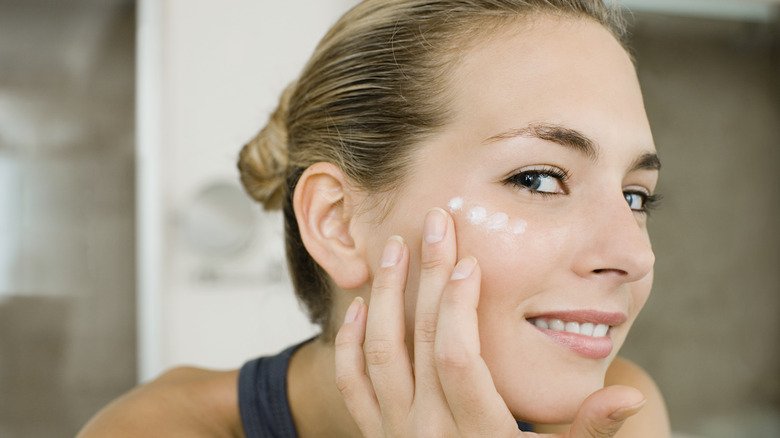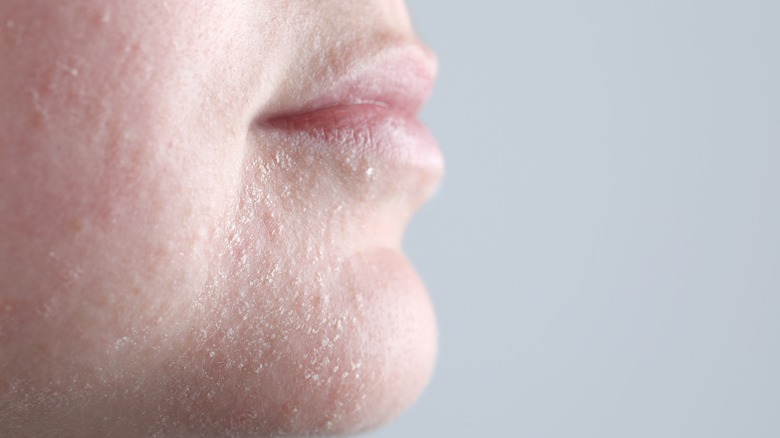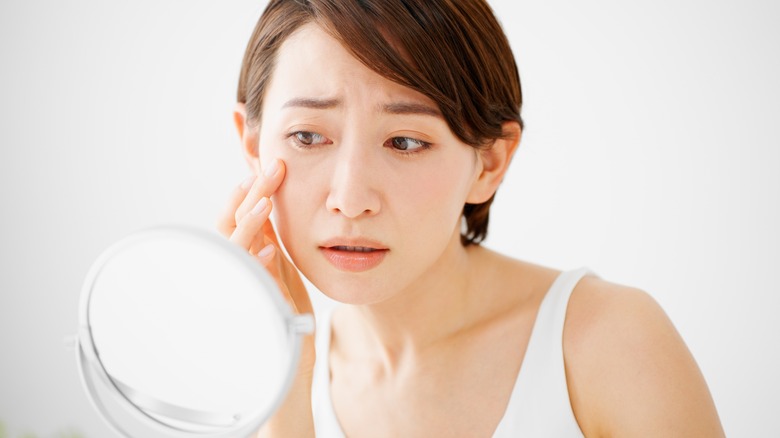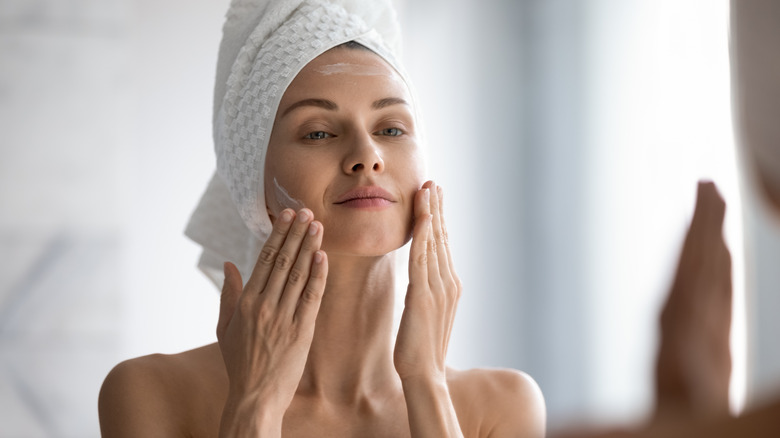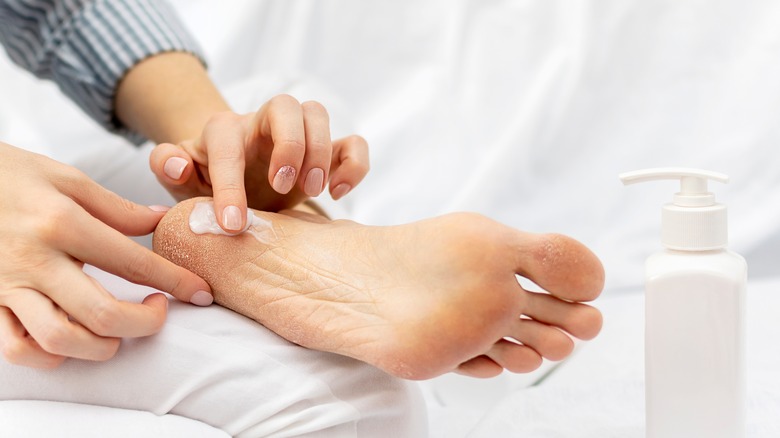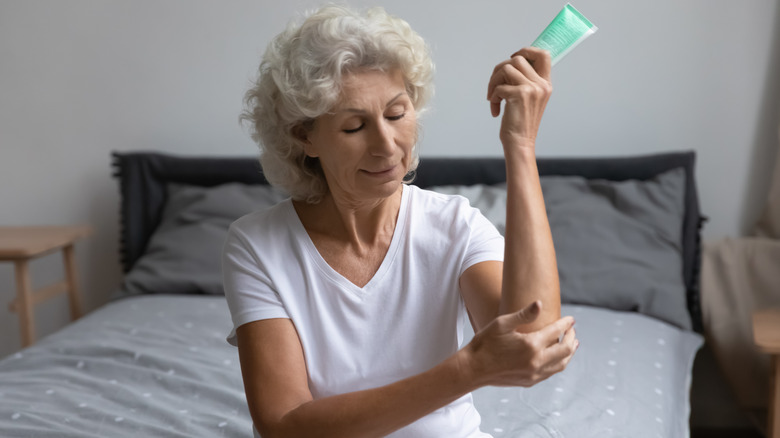Mistakes You're Probably Making With Your Moisturizer
If you've ever had skin that feels tight and dry, you know how good it feels when you finally put on some moisturizer. And there's nothing like the feeling of smoothness and suppleness that comes from well-moisturized skin. Plus, it can make you look younger — skipping moisturizer is one of the bad habits that are making you look older.
Having well-moisturized skin doesn't just feel good, it has potential health benefits. Dermatologist Mara Weinstein Velez explained to Byrdie that moisturizer "helps to prevent environmental damage to your skin as it acts as a protective barrier."
That barrier is a natural one, and your body can and will make everything you need to have moisturized skin. But things can get out thrown off balance, and you can end up with dry or flaky skin. Your skin can lose moisture because of external factors, like the dry air of winter, or it can be a more inherent condition. All that can be countered by using moisturizer, but there are some mistakes that you might be making as you try and tackle dry skin. Here are some common missteps, and how to avoid them.
Not understanding if your skin is dry, dehydrated, or both
A moisturizer, broadly speaking, is used to describe a skincare product that brings water to and keeps water in your skin, but it's a bit more nuanced than that. Understanding that nuance is key to making sure you're not making a mistake in which product you're choosing.
What's tricky is that your skin feeling dry can mean different things; you could have dry skin or you could have dehydrated skin. If you have dry skin, you're lacking a healthy level of sebum, an oil produced by your sebaceous glands. It can be an ongoing issue where your skin just doesn't make as much sebum. In contrast, dehydrated skin has enough oil, but it doesn't have enough water. It can be caused by things that strip your skin of its protective layers, like extra long, hot showers or spending time cold, dry weather, per CeraVe. You can have both oily and dry skin that's also dehydrated. And the best products to combat dry skin vs. dehydrated skin aren't always the same.
You might be applying your moisturizer in the wrong order
Choose the right skincare product based on the reason behind your dry-feeling skin. Products with hydrating ingredients, or humectants, help bring water to your skin's outer layer, therefore addressing dehydrated or ashy skin. Hydrators include things like hyaluronic acid and some alpha hydroxy acids. A moisturizer uses emollients and/or occlusive ingredients to help keep your skin barrier intact and keep the water in your skin, in a way acting like sebum, which can help with dry skin. Moisturizers help maintain your current skin hydration, so they work well when paired with hydrators if you have dehydrated skin, and they help prevent normal skin from drying out. Active ingredients in moisturizers can include shea butter, ceramides, squalane, petroleum jelly, and beeswax.
If you're using separate skincare products for hydrating and more moisturizing, make sure that you apply the hydrating product first and follow it with a moisturizing product. If you put the moisturizer on first followed by a hydrator, the barrier that the moisturizer creates to help your skin from losing water will prevent other products from penetrating the skin, which means they're not effective. That's why, when you apply something like a hyaluronic acid on your skin, you want to follow it with a moisturizer. Otherwise, you could end up with even drier skin than before.
You might be choosing the wrong moisturizer for your skin type
Sebaceous glands are found most predominantly on your face and scalp, which means you need to treat that skin differently than the rest of your body when it comes to moisturizing. Particularly when you choose the moisturizer that you're going to be using on your face, you need to keep your skin type in mind. If you have oily skin, you'll be familiar with the greasy feeling that can show up most often on your T-zone. But even if your skin type overall is oily or if you're battling acne, you can still have dehydrated skin. And some acne-fighting products like benzoyl peroxide or salicylic acid can lead to a temporary drying out of your skin. Use a lightweight, oil-free, non-comedogenic, gel-based moisturizer to get moisture without clogging your pores.
If you have dry skin — not just dehydrated skin — make sure that your moisturizer contains occlusive ingredients to keep that precious moisture from evaporating. Opt for a thicker, heavier oil-based cream so your face doesn't end up feeling dried out and rough by the end of the day.
You're applying it at the wrong time or in the wrong place
Remember how the moisturizing ingredients help keep water in your skin instead of evaporating away? That's a big part of the ideal timing for applying moisturizer. To get the most out of your moisturizer, apply it when your skin is clean and damp. Gently pat your skin dry after a bath or shower so you're not soaking wet but still aren't fully dry, and promptly put on your moisturizer. It will keep your skin smooth and plump longer than it would if you apply it to fully dry skin.
And moisturizers really are designed for the body part that you're putting them on. You wouldn't put a light eye cream — designed to be absorbed by the delicate skin around your eyes — on your hands or on your heels and expect the same result. And you shouldn't use hand cream or body butters on your face, since they're likely to be too thick and potentially too oily, doing more harm than good over time.
You forget to exfoliate before moisturizing
Moisturizers are designed to keep your skin hydrated and happy. But if you put it on without considering what else you've done — or not done — to your skin before smoothing on your moisturizer, you could be making things worse. Putting on moisturizer can slow your body's ability to naturally shed dead skin cells, and you can end up with patchy, dull-looking skin.
Help prevent that by using products that promote dead skin cells to slough off and new cells to generate, like fruit acids and retinol before you moisturize. If you're going to go with a more aggressive chemical peel, do it with a dermatologist or aesthetician to keep your skin safe. When it comes to your body, you can help get rid of dead skin cells by gently scrubbing with a washcloth or loofah in the shower or bath, or you can try dry brushing. Don't over-exfoliate though, since that can lead to your skin drying out leading to a vicious cycle of trying to keep your skin healthy. Once a week should be enough for a good full-body exfoliation.
You're using too much moisturizer or not enough
It may feel good to slather on a lotion or cream when your skin is feeling dry, but be careful, you can over-moisturize. You're wasting product and you're causing more problems. Dermatologist Howard Sobel told Teen Vogue that "Excellent moisturizers are typically very concentrated and are meant to deliver small amounts for all skin types." Adding more product won't mean you have super hydrated soft skin; it will mean that you're setting yourself up for clogged pores and a weakened skin barrier. Use around a nickel-sized amount of moisturizer on your face and neck twice a day. For your body, it can depend on the humidity levels where you live, but once a day is probably enough.
Conversely, there are some parts of your body that have thicker skin and that can be dryer than others, like the soles of your feet, your elbows, and your knees. Consider using a heavier cream on those areas to keep that skin soft. And your hands can dry out much quicker than other body parts, particularly if you wash your hands a lot during the day.
